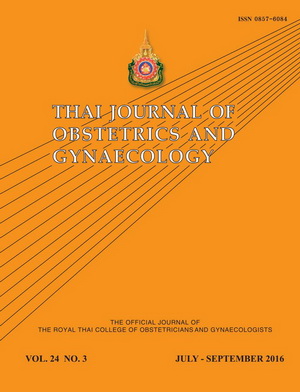Comparison of Pregnancy Rate Following IUI between the Use of Husband’s Sperm and Donor’s Sperm in Siriraj Hospital
Main Article Content
Abstract
Objectives: To compare pregnancy rate resulting from IUI between the use of husband’s sperm and donor’s sperm.
Materials and Methods: Data on 306 cycles per groups of IUI using husband’s sperm (IUI-H) and IUI using donor’s sperm (IUI-D) were collected from couples attending Infertility Unit at Siriraj Hospital. Baseline data, as semen analysis parameters were retrieved. Pregnancy rate was compared between groups.
Results: Mean age of the women was younger among IUI-D than IUI-H group (33.6±5.3 vs. 34.4±3.4 years, p=0.025). And their husbands were older among IUI-D than IUI-H group (38.0±8.1 vs. 35.4±3.8 years, p<0.001). Women in IUI-H group were more likely to be nulliparous than IUI-D group (97.1% vs. 92.5%, p=0.011). Anovulation in IUI-D is higher than IUI-H (13.1% vs. 8.5%, p<0.001). Ovulation induction regimen and number of follicles were comparable both groups. IUI-D group were significantly likely to have endometrial thickness ≥ 8 mm (79.7% vs. 65.4%, p<0.001). Post wash semen concentration and progressive sperm motility were
significantly higher among IUI-H than IUI-D group (70.8±21.6 vs. 42.5±6.7x 106/mL, p<0.001, and 88.9±5.0 vs. 83.6+8.1%, p<0.001, respectively). Overall pregnancy rate was significantly higher among IUI-D than IUI-H group (9.8% vs. 5.6%, p=0.048). Logistic regression analysis demonstrated that the use of donor’s sperm and follicles of ≥2 independently increased pregnancy rate (adjusted OR 2.2, 95%CI 1.2-4.3, p=0.018; and 3.5 95%CI 1.7-6.9, p<0.001).
Conclusion: Pregnancy rate was significantly higher among IUI cycle using donor’s sperm.
Materials and Methods: Data on 306 cycles per groups of IUI using husband’s sperm (IUI-H) and IUI using donor’s sperm (IUI-D) were collected from couples attending Infertility Unit at Siriraj Hospital. Baseline data, as semen analysis parameters were retrieved. Pregnancy rate was compared between groups.
Results: Mean age of the women was younger among IUI-D than IUI-H group (33.6±5.3 vs. 34.4±3.4 years, p=0.025). And their husbands were older among IUI-D than IUI-H group (38.0±8.1 vs. 35.4±3.8 years, p<0.001). Women in IUI-H group were more likely to be nulliparous than IUI-D group (97.1% vs. 92.5%, p=0.011). Anovulation in IUI-D is higher than IUI-H (13.1% vs. 8.5%, p<0.001). Ovulation induction regimen and number of follicles were comparable both groups. IUI-D group were significantly likely to have endometrial thickness ≥ 8 mm (79.7% vs. 65.4%, p<0.001). Post wash semen concentration and progressive sperm motility were
significantly higher among IUI-H than IUI-D group (70.8±21.6 vs. 42.5±6.7x 106/mL, p<0.001, and 88.9±5.0 vs. 83.6+8.1%, p<0.001, respectively). Overall pregnancy rate was significantly higher among IUI-D than IUI-H group (9.8% vs. 5.6%, p=0.048). Logistic regression analysis demonstrated that the use of donor’s sperm and follicles of ≥2 independently increased pregnancy rate (adjusted OR 2.2, 95%CI 1.2-4.3, p=0.018; and 3.5 95%CI 1.7-6.9, p<0.001).
Conclusion: Pregnancy rate was significantly higher among IUI cycle using donor’s sperm.
Article Details
How to Cite
(1)
Tankul, A.; Prechapanich, J. Comparison of Pregnancy Rate Following IUI between the Use of Husband’s Sperm and Donor’s Sperm in Siriraj Hospital. Thai J Obstet Gynaecol 2016, 24, 175-183.
Section
Original Article


